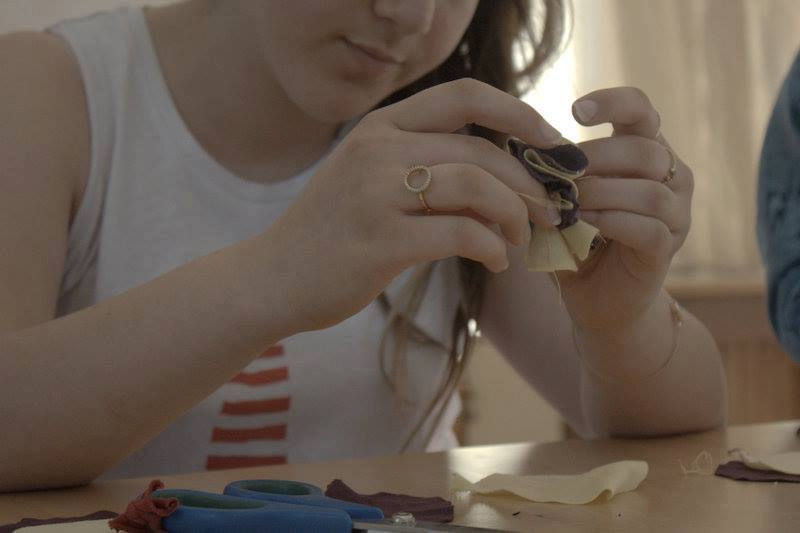Last week I had a large group of students in the summer sewing classes. When that happens I divide them into 2 groups, each one with their own instructor.
The students in one of the groups were beginners so they learnt basic hand stitching and made fabric flowers, yoyos and stitched buttons on their bags. They learnt to sew on the machine and made pillows, bags, pouches and dolls.
The students in the second group have been coming for a number of years and all know how to sew on a machine and do various hand stitches. I always create new items and new tutorials for students that have participated in a few summer sewing classes.
This year I decided to teach them slow stitching and place an emphasis on hand work, embroidery, embellishment and reuse.
The enitre goup comprised teenagers who are already very fashion concious and have begun to become eco aware. they do teach them a bit at schools here, to my mind nearly not enough.
For example, there are used clothing collection bins placed in strategic areas around the city. I asked them if they are aware of these bins and they all said yes. I asked them where the clothing goes after collection. They unanimously said "to charity". WRONG the clothing is collected by one of the for profit textile recycling companies that exist in this country.
I then proceeded to explain to them what happens to their clothing once the collection has been made from the bins. They were appalled, not to say the least. They all thought that the clothing that they had put in the bins was going to a needy family. I put them straight on that by explaining that needy families don't really want the affluent societies hand outs, they would like to earn money and go out and buy their own. It was an opportunity which I couldn't pass up and had a very short discussion with them about the way social services that the Governement provides (or rather SHOULD provide) should run in a country.
We then moved on to what does happen to the clothing. Africa doesn't want our castoffs anymore and neither does India. So what can we do with all this stuff that we have. I suggested that they set themselves a challenge to see whether they could have a NOT buy month and lighten their individual footprint a little bit. They could set this challenge up in class and make a competition and then compare notes at the end of the month.
I told them that seeing as they all know how to sew well on a machine already it was time to improve their handsewing skills. What if they didn't have access to a machine? Or couldn't buy new fabric? Did that mean that they couldn't sew a bag or a piece of clothing? They were curious as to what I could do with them for 5 mornings that would entail only handsewing and using upcycled fabrics..
We started out with embroidery. Each one was given a cotton panel, they drew pencil lines on it and created a sampler with a number of basic embroidery stitches that combined together could give other visual options.
Their instructor showed them her second sampler from her slow stitching class. She used a feather stitch, pinwheel stitch, french knot and extended french knot to get this result. She also used chain stitches to create the open leaves.
They were then given a pattern and cut out pieces of fabric for a lined clutch bag with a flap closure. They then designed their embroidery design on a piece of paper and spent 2 mornings embellishing and embroidering the flap of the clutch bag.
They were given bottles of beads and buttons which they could also use in addition to making yoyos and using embroidery thread.
The flap taking shape.
They learnt to make a number of fabric flowers and I always send them to pinterest and google. I only have a set number of hours to teach them and there are Sooo many things to learn.
They learnt to embellish a t shirt using only upcycled buttons.
I showed them how one could sew a t shirt by cutting up a used t shirt (an old school shirt or an old shirt from someone in the family) and stitch by hand using a simple back stitch.
The second instructor brought her t shirt that she had made and embroidered on to show them her result.
They learnt that it is possible to sew without a machine and still make beatiful pieces and create a wardrobe without being dependent on anything or anyone else.








Opmerkingen